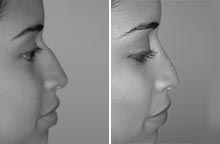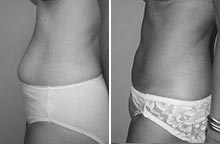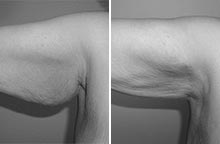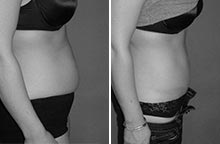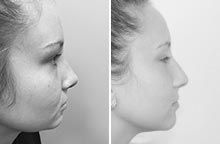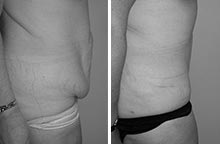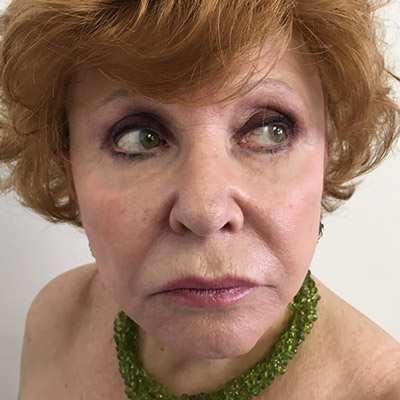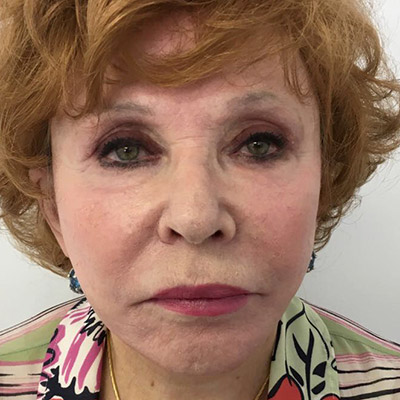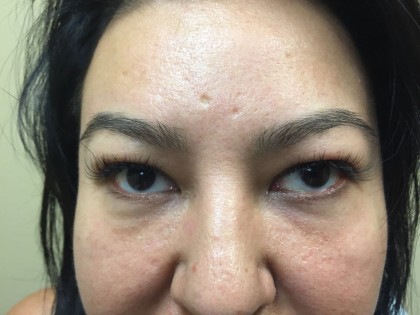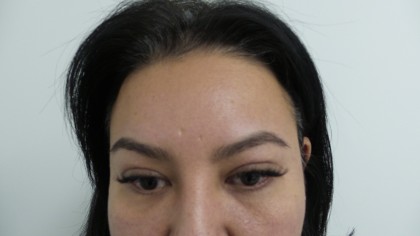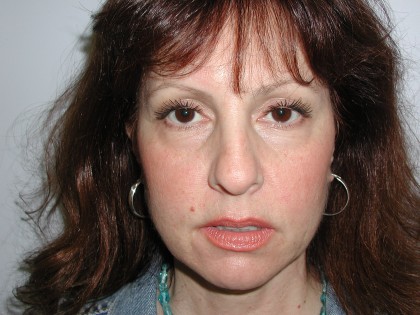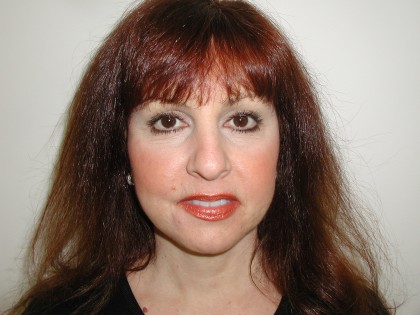Facelift
Consultations offered at our three convenient locations in New Jersey, Bergen County and Englewood, NJ

A facelift, also called rhytidoplasty, is a surgical procedure to address signs of aging in the forehead, midface, and neck regions. Patients looking to improve the appearance of loose, sagging skin, unwanted fat deposits, and wrinkles will find that a facelift can help turn back the clock. While other minimally- and non-invasive treatments and procedures can address some signs of aging, none offer the same long-lasting dramatic results as a facelift.
Patients seeking facial rejuvenation surgery need look no further than Dr. David L. Abramson, MD, a board-certified plastic surgeon serving Englewood, and Franklin Lakes, NJ residents and New York City. Dr. Abramson has created new techniques for facelift surgery by leading the pack with his expertise and innovative ideas. Ready to find out more about Dr. Abramson’s approach? Call one of our offices to schedule an appointment for your consultation: in New Jersey, call (201) 731-3134 for our Englewood or Franklin Lakes locations, or in New York City, call (212) 774-1828. You can also contact us via this form to book a facelift consultation.
Want to stay informed about Dr. Abramson’s specialized techniques? Follow along on our blog!
Contents
- 1 Before & After Photos
- 2 Before and After Photos
- 3 Why Choose Facelift Surgery?
- 4 Facelift Candidates in Manhattan
- 5 How Does the Face Age?
- 6 Facelift Techniques
- 7 Addressing the SMAS
- 8 Procedure
- 9 Extended Facelift
- 10 The Benefits of an Extended Facelift
- 11 What to Expect from an Extended Facelift
- 12 Ask About the Unique Aspects
- 13 Choosing a Plastic Surgeon
- 14 Training and Board Certification
- 15 Research Their Results
- 16 Check Out the Facility Where the Surgery Will Be Performed
- 17 At Your Visit With the Plastic Surgeon
- 18 Take Your Time When Choosing a Facelift Surgeon in Englewood
- 19 Your Consultation with Dr. Abramson
- 20 Preparation
- 21 Six Weeks Before Your Facelift
- 22 Two Weeks Before Your Facelift
- 23 One Week Before Your Facelift
- 24 Reach out for More Information
- 25 Facelift Recovery
- 26 Seeing Your Results
- 27 Schedule a Consultation
- 28 Ancillary and Alternative Procedures
- 29 Cost of Facelift Surgery in Manhattan
- 30 References
Before & After Photos
Before and After Photos
Why Choose Facelift Surgery?
While the experience and wisdom gained from a life well-lived are priceless, you would be hard-pressed to find someone who values wrinkles, sagging skin, and an aging face. Often, we feel much younger than we look, which is why so many people opt for an aesthetic procedure. Every year, the demand for anti-aging solutions grows. The number of facelift surgeries performed increased by 75% from 2000 to 2020. [1]
Patients looking to recapture their youthful appearance have many options, but the enduring effects of facelift surgery are unparalleled. A facelift can reposition sagging features by addressing the deep layers of facial tissue. As we age, a reduction in collagen production causes wrinkles and fine lines to form. Whether up close (wrinkles) or far away (volume loss), no matter how you look at it, aging is no fun, and holding on to a youthful appearance is impossible without assistance.
While all faces age, no two faces age in the same way at the same rate. Therefore, the beauty of a facelift is the ability to personalize the procedure for each patient. Restoring the deepest layers of tissue to a more aesthetically pleasing position, removing excess skin, and performing ancillary procedures such as fat grafting, chemical peels, or laser resurfacing will help our patients reach their cosmetic objectives. Patients appreciate a refreshed appearance and confidence boost with a facelift.
Facelift Candidates in Manhattan
Ideal candidates for facelift surgery are men and women in good health who are non-smokers. Depending on patient health, candidates for surgery can range in age from 40 to 70 or 80.
Candidates for facelift surgery are dissatisfied with their appearance, which may include:
- Noticeable skin folding
- Deep creases around the mouth and under the eyes
- Loose skin around the jawline (jowls)
- Double chin
- Upper neck laxity
- Cheek volume loss
- Facial fat pad loss
Dr. Abramson will spend your consultation getting to know your wants and desires so he can create an individualized plan just for you. If you are unhappy with your moderate to severe facial laxity, schedule a private consultation by calling (212) 774-1828 in Manhattan or (201) 731-3134 in New Jersey.
How Does the Face Age?
It is worth noting the individualized way different skin types age. People with thicker skin experience more sagging, while those with thin skin experience increased wrinkling. For most of us, wrinkles start to form in our late 20s, beginning in places with the most delicate skin. Over time, the components that make up our youthful skin begin to atrophy, and collagen synthesis decreases. Did you know that collagen makes up 70% to 80% of the dry weight of the dermis? As collagen decreases, dermal thickness increases by 6% every ten years producing increasingly lax skin. [2] Chronic exposure to ultraviolet light can also cause collagen and elastic fibers to decrease. Additionally, the volume associated with a youthful face decreases as the subcutaneous fat layer becomes thinner – think of the term “baby fat.” Finally, mimetic wrinkles – i.e., “laugh lines,” “worry lines,” and the like – round out the aging buffet to create a tableau of features that may decrease confidence and make it challenging to meet the world face to face.
Facelift Techniques
Dr. Abramson knows his patients want to look refreshed, not “pulled,” or with a final look that reads “done.” So he prides himself on beautiful, natural-looking results no matter which technique he uses. There are many different ways to perform a facelift, but the primary methods use the traditional or extended incision.
Traditional Facelift
The traditional facelift begins with a thin incision at the temples, running along the hairline and around the earlobe. Sometimes, the incision is extended if the patient wants to reduce the jowls. Fat is reshaped, underlying layers of tissue are repositioned, and loose skin is excised and redraped through this process. The incisions are then sutured closed; scarring is minimal as the incision lines blend into the border of the hairline and ear. A traditional facelift diminishes fine lines and wrinkles, leaving patients with a youthful, vibrant appearance.
Extended Facelift
The extended facelift is similar to the traditional but requires a longer incision as it addresses a larger area. Rather than stopping at the earlobe, the incision continues along the back of the ear to meet the hairline. Underlying muscles, fat, and tissue are adjusted to create a natural contour of the face. Loose, sagging skin of the face, jaw, and upper neck is appropriately excised and redraped, diminishing wrinkles and creating a smooth, contoured look.
Sometimes, a mini or partial facelift may be done on selected areas.
Turn Back the Clock
The face is comprised of several complex layers of tissue, all of which undergo changes with the passage of time. The skin, subcutaneous fat, superficial and deep fascia, mimetic muscles, facial nerves, arteries, and veins are all carefully considered during a facelift.
As we age, our skin length increases by around one-and-a-half centimeters per decade. So, by excising that same amount of skin, patients can turn the clock back by ten years! [2] Imagine yourself an entire decade younger.
Addressing the SMAS
One thing that sets Dr. Abramson apart is his deep knowledge of the SMAS or superficial musculoaponeurotic system. The SMAS is the connective tissue layer below the skin and above the muscles of the face. By suspending these deeper tissues of the face, Dr. Abramson can avoid giving his patients the “wind-swept” look because the overlying skin is not the only aspect receiving a lift. Think of this in terms of a home restoration: repairing the foundation will always be preferable to just applying a pretty coat of paint. This technique preserves and reunites the skin with the underlying SMAS structure to increase focused attention on specific face areas. [3] It gives Dr. Abramson incredible control as he applies the techniques perfected during his many surgical reconstruction cases to achieve stunning cosmetic results.
Procedure

Dr. Abramson will perform your facelift surgery in an operating room with anesthesia administered by a board-certified anesthesiologist. The total surgical time will last from three to four hours.
After surgery, you will remain under observation to ensure you have responded well to surgery. You should arrange for transport home after your procedure and help the night following surgery. Additionally, you may need help around the house in the following days, especially if small children are at home. Over the next few weeks, you’ll return to Dr. Abramson’s offices for your regularly scheduled follow-up appointments.
Extended Facelift
When you are seeking a comprehensive facial enhancement, the extended facelift in Englewood is one you should consider. This procedure, which is similar to traditional facelifts, offers a larger coverage area due to longer incisions. The key advantage is the reduced visibility of scars and the ability to address the middle and lower parts of your face.
In addition, the muscle, fat, and tissues underneath the skin are adjusted to give your face a natural contour. Any loose or sagging skin is excised and re-draped from your face, upper neck, and jaw, smoothing wrinkles. This process ensures that your results are not only noticeable but also look completely natural.
When you are ready to take the next step, our highly skilled and experienced facelift plastic surgeon will evaluate you and monitor your progress throughout the procedure. This ensures that you can feel safe and confident in our hands and, ultimately, satisfied with your results.
The Benefits of an Extended Facelift
Dr. Abramson and his highly dedicated staff in Englewood are excited to offer the extended facelift. This advanced treatment uses a longer incision than a traditional facelift to address a larger area. Instead of just stopping at the earlobe, the incision travels along the back of the ear to meet the hairline for a more comprehensive treatment.
With this technology, we can tighten and lift the middle and lower parts of your face, correcting your cheeks, neck, and jawline. We can also address the superficial musculoaponeurotic system (SMAS) layer, a deeper tissue beneath your skin, for longer-lasting results.
The intricacies of this procedure allow for less visible scarring because the incisions go behind your ear and into your hairline. You will appear more natural without creating an overly tight or “pulled” appearance. Our goal is to help reverse signs of aging so you can feel more confident in your personal and professional life!
What to Expect from an Extended Facelift
Dr. Abramson will provide you with a thorough consultation and evaluation before undergoing an extended facelift in our Englewood office. Most importantly, your overall health and pre-existing medical conditions will be assessed, and additional medical tests may be requested.
As we walk you through the procedure, we will discuss expected outcomes, potential risks, and your recovery process. You may be given pre-operative instructions, such as temporarily stopping medications that can increase the risk of bleeding or quitting smoking.
To ensure your comfort, you will be placed under general anesthesia, and we ensure that your procedure is safe and sterile.
Post-Procedure Instructions
After your surgery, your incisions will be closed with sutures, and you will be monitored in our recovery area as the anesthesia wears off. There may be some discomfort and swelling, but pain medication can help alleviate these symptoms. In addition, it may take several weeks or months for inflammation to subside, for tissues to settle into their new position, and to heal fully.
It is important to follow your post-operative instructions, including:
- Avoiding sun exposure
- Attending follow-up appointments
- Using specialized skincare products
- Refraining from strenuous activities
Complications are rare but can occur, such as infection, bleeding, hematoma, nerve damage, and common risks associated with anesthesia. Contact us if you have any concerns.
Ask About the Unique Aspects
To give your face the maximum lift and enhancement, you may need more work than a traditional facelift can provide. When this is the case, consider an extended facelift in Englewood. Our board-certified plastic surgeon, Dr. Abramson, will assess you so you can receive the best treatment!
Reach out to our office today for more information on this amazing opportunity or to schedule a consultation with Dr. Abramson. We look forward to hearing from you soon.
Choosing a Plastic Surgeon
When you are having any type of surgery, you want to be sure your surgeon is well qualified and has a history of good results. It is important that you know what to look for when choosing a plastic surgeon for a facelift in Englewood. Facelift surgery is a complex procedure and you want someone who is well-trained and attuned with your goals. Dr. David Abramson will make you comfortable and confident in your choice when you go in for your initial consultation.
Training and Board Certification
You need to be careful as you investigate a plastic surgeon’s qualifications. Be on the lookout for boards or certifications that sound good but may not signify much. You are looking for a board certification by the American Board of Plastic Surgeons (ABPS), which is recognized by the American Board of Medical Specialties (ABMS). The ABMS is the oversight organization for all major medical certification boards.
It is also important to ask what type of training the doctor had after medical school and what type of residency they completed. They should have a minimum of six years of surgical training with at least three years instruction specific to plastic surgery. You might want to ask whether they actively participate in continuing medical education (CME) so that they are keeping their knowledge up-to-date. Physicians are regularly improving treatments and techniques so you want a facial plastic surgeon who knows the most recent techniques for facelift surgery.
You should also find out if they are a member of the American Society of Plastic Surgeons. By being a member of this organization, they are telling you that they meet high standards.
Research Their Results
Looking at a photo gallery of the surgeon’s work is very important to gain an idea of their breadth of experience and knowledge. You should see a gallery of different types of problems they have successfully addressed with a facelift. Taking care of a wide range of issues means the surgeon will have the depth of knowledge to take care of unexpected findings.
As you are looking through the before and after gallery you should be able to pick up on whether the after photos match the type of results you are looking for. Every plastic surgeon has their own “style” which is borne of a combination of artistry and technical skill. If you do not like what you see, then you may want to look for a different surgeon so that your preferred results will match their style.
Reviews and testimonials can be extremely helpful when choosing a facelift surgeon in Englewood, but also look for reviews on other aggregate websites.
Check Out the Facility Where the Surgery Will Be Performed
Make sure that you know where your facelift will be performed. It could be a stand-alone surgical center or you could have surgery at a hospital. Do not hesitate to ask about the facility’s accreditations. An accreditation means that the facility is meeting a certain set of standards. They will have the needed equipment and plans to handle any medical emergency so that you can feel safe.
At Your Visit With the Plastic Surgeon
Be sure to bring questions during your consultation. You will want to know what treatment options exist for your issues. Is a facelift your only option, or could you choose a different treatment? You may want to discuss what techniques will be used for your facelift. A good surgeon wants you to ask questions and is willing to answer them with complete honesty.
One of the goals of the initial consult is to make you feel comfortable with this medical professional, to the point where you can schedule your operation day.
Take Your Time When Choosing a Facelift Surgeon in Englewood
If you want a board-certified plastic surgeon with great experience and knowledge of the more recent techniques, then you should meet with Dr. David Abramson. He has a keen eye when it comes to facial and body aesthetics which he applies to every patient’s procedure. Both Dr. Abramson and his staff are here to answer questions, explain the procedure, and provide anything else you need in order to feel ready for surgery. Call us to learn more about why Dr. Abramson is your choice for facelift surgeon in Englewood.
Your Consultation with Dr. Abramson
During your consultation with Dr. Abramson in Manhattan, Englewood, or Franklin Lakes, you will have the opportunity to discuss your concerns frankly. Explain any issues you have with your face or other procedures or treatments you’d like to learn more about. Dr. Abramson will assess your health as well as the condition of your skin to determine if you are a good candidate for surgery. A critical aspect of patient satisfaction is the willingness to embrace realistic expectations. You can view before and after photos of Dr. Abramson’s patients; results vary between patients, but this will help you gain a general idea of your outcome. You may also wish to bring in a photo of your younger self to help guide your natural-looking results.
Once your health exam is completed, during which you should disclose all medications you are taking and any past surgical procedures, Dr. Abramson will walk you through your surgery. You will then understand, step by step, what the process entails. Before you leave the office, our staff will provide you with a list of actions to complete before surgery and also a list of recovery practices to ease you through aftercare.
To schedule your consultation at our Manhattan or New Jersey office, call (212) 774-1828 or (201) 731-3134.
Preparation
Facelift preparation and surgery in Englewood can be a transformative journey. During this procedure, underlying tissues are tightened and repositioned, removing excess skin and smoothing out wrinkles, ultimately restoring your face’s youthful and vibrant appearance.
Facelift surgery is routinely done as an outpatient procedure, so you can go home the same day. With this in mind, you want to be ready for your facelift and it is important to understand critical preparations and the process beforehand.
Six Weeks Before Your Facelift
It is best to start preparing for your Englewood facelift as soon as six weeks in advance. This gives you adequate time to get everything in order.
Quit Smoking
If you smoke, you need to stop at least six weeks before your surgery. Smoking can slow healing, hindering you from getting the best results. This timeline is important because it takes six weeks to get the harmful chemicals fully out of your system. We never recommend you restart smoking if you want to keep your fabulous new face in good shape, but if you must, you should not restart until six weeks after your procedure.
Manage Your Diet
Several weeks before surgery is an excellent time to check other lifestyle habits. Are you eating lots of fresh food, including fruits, vegetables, and protein? You should try to cut out drive-thru and ready-to-heat frozen meals as much as possible.
In addition, start to limit your alcohol intake to only special occasions to keep it light. Likewise, drink at least eight glasses of water every day! Hydration is vital to skin upkeep, so you must be well-hydrated to help progress the healing process.
Request Time off Work
Another essential preparation before surgery is taking adequate time off work for recovery. The amount of time you need will depend on what surgery is done and the type of job you have. Be sure to discuss this with Dr. Abramson so that you know you are requesting enough time.
Two Weeks Before Your Facelift
Following the six-week breakdown, you will need to prepare for certain factors closer to the time of the procedure. There are certain steps to take within the two-week window.
Stop Certain Medications
About two weeks before surgery, you must stop most blood-thinning medications, including over-the-counter pain relievers. These can increase your risk of bleeding at the time of the procedure.
Certain herbal supplements also present a problem. At your first appointment, be sure to tell us about all medications and supplements you take so that we can inform you of what is safe to continue and what you need to stop taking.
One Week Before Your Facelift
You need to start final arrangements about one week before surgery. It is best to prepare as much as possible beforehand to make your recovery much more manageable.
Find a Designated Driver
You will need help from family or friends on the day of surgery and for a few days after. Arrange for a driver to get you home safely afterward and for your first post-op visit.
Prepare Pain Medication
You should have pain medications ready when you arrive home, and you do not want to run out of routine medicine shortly after surgery. In addition, you will have antibiotics post-op. If you have any questions about whether you should take a particular medication, be sure to discuss this with us at your first appointment during recovery.
Arrange for Childcare, if Necessary
If you have young children at home, make arrangements for their care on the day of surgery. This is the perfect time for a visit to grandparents or a favorite aunt or uncle. You want to be comfortable and know your children are being cared for so you can cross that worry off your list.
Similarly, be sure you have someone to help you for at least part of the time during the first few days after surgery. Keep in mind that you will be unable to drive and perform specific tasks during this period.
We can provide more in-depth knowledge of our facelift preparations in Englewood during a consultation.
Reach out for More Information
Dr. Abramson and his staff are determined to make your aesthetic goals a reality. Contact our office for more information on facelift preparation in Englewood to get started.
We can schedule a consultation with you during which all your questions will be answered. Please do not hesitate to reach out today for more information on how to prepare for the pre-op and post-op periods.
Facelift Recovery
Your skin loses elasticity as you age, and the underlying tissues become thinner. As gravity takes its toll, you may notice facial tissues sagging and wrinkles appearing.
A facelift can reverse many signs of aging and give you a more youthful appearance. If you are considering this popular facial surgery procedure, we can provide helpful information about facelift recovery and results in Englewood to prepare for it.
Immediately after surgery, you must emphasize resting. You will also need someone to drive you home and stay with you that first night.
Make sure you have filled your pain medication prescriptions before surgery so they will be available when you arrive home. This medication will be most necessary for the first 24 hours and you may also want to use cold packs to help minimize swelling, bruising, and pain.
After your procedure, you will have a brief post-op visit to the office soon after. During this, we will check your incisions and redress them. You should have someone to drive you to and from this appointment, especially if you are using narcotic pain medications.
Week One Post-Op
As the first week progresses, you will start to feel better and be able to move more. Swelling and bruising usually reach their maximum around days three and four post-procedure. Keeping your head elevated is essential, so have two pillows under your head when lying down.
By the end of the week, you may feel like doing light housework or cooking and can certainly return to walking. Movement will help your body decrease the swelling. That said, more strenuous activities should wait until the end of the first month.
Week Two Post-Op
During week two, bruising and swelling should be much reduced but not completely gone. You may still need pain medications, though discomfort has usually reduced. Patients may also notice tightness in the face, along with numbness and tingling. This is brought on by pressure from the excess fluid in the tissues and will slowly improve as the swelling dissipates. In addition, you will slowly increase activity throughout this week and will likely be ready to return to work by the end of it.
Week Three Post-Op
Bruising and swelling continue to improve during week three post-procedure. Further postop visits will be scheduled, including ones for suture removal, and by the end of the fourth recovery week, you should be getting back to regular activities, including your usual exercise routine.
One important thing to remember during your facelift recovery is that our Englewood office is always available. We can answer questions and help with any concerns you have. Never hesitate to call!
Seeing Your Results
For the first few weeks, swelling will make it difficult to see true results. If you had work done to decrease jowls and sagging skin, you might notice certain things almost immediately, like a significant improvement in your neck and under-chin area. Seeing the changes around your eyes or in your cheeks will take longer but will slowly emerge as excess fluids leave those areas.
It can take as long as a year before you see the final result. Remember that it is vital to follow all post-op instructions, as this will help you reach the best outcome possible. If you have concerns, our Englewood office will support you throughout your facelift recovery and can answer inquiries about the results you are seeing.
Schedule a Consultation
Be sure to ask any questions you have about facelift recovery and results in Englewood as you are preparing for surgery. We want your new, more youthful face to look its best but we also want you to feel comfortable every step of the way as you experience the changes the facelift will produce.
When you are ready to take the next step, call to set up an initial consultation.
Recovering from surgery requires putting your calendar on hold for up to two weeks. After that time, or somewhat sooner, you will be able to return to your life and work. Considering the overall improvement that facelift surgery will bring your life, the recovery process will be just a blip on the timeline. Following Dr. Abramson’s postoperative instructions, your final, rejuvenated results will fully settle in four to six weeks.
You will be sent home with head and neck dressings or an elastic garment – plan to wear these for the first several days to aid in recovery and reduce swelling. Swelling and bruising are expected and will subside quickly, especially with ice packs. Once the swelling goes down, your beautiful results will begin to emerge. Sutures will be removed at the follow-up appointment, and Dr. Abramson can assess the healing progress.
Patients should take note of the following aftercare precautions:
- Do not take anti-inflammatory medications as they may increase the amount of bruising.
- Gather your pain medication before the day of your surgery to ease any discomfort once you’re back home.
- Take proper precautions with sun exposure and skin damage.
Follow these suggestions, and you will enjoy long-lasting results for the next decade – prepare to be delighted with your reflection for a long time!
Ancillary and Alternative Procedures
While a facelift is an excellent approach to bringing vibrancy to the face, some procedures and treatments may be paired with a facelift to enhance results further.
Dermal Fillers
Dermal fillers are often used with a facelift to add youthful volume and contour to the face. Dr. Abramson proudly offers Juvéderm, Radiesse, and Restylane products to address an array of aesthetic desires.
Fat Grafting
Facial fat grafting is a beautiful alternative if a patient wants facial volume without using dermal fillers. Facial fat grafting is a procedure that takes fat from one location of the body, purifies it, then injects it into the cheeks, temples, or lips for natural augmentation. The benefit of fat grafting is the incorporated body sculpting from liposuction.
Brow Lift
Alternatively known as a forehead lift, a brow lift surgically raises the eyebrows to a youthful, more proportionate position on the face. Drooping eyelids are also lifted, creating a more awake and alert appearance. Often, a tired appearance is due to a low brow position as opposed to excess eyelid skin. In addition, wrinkles on the forehead and between the eyebrows are diminished with a brow lift, reversing stubborn signs of aging.
Eyelid Surgery
Eyelid surgery is a common alternative to a facelift when patients do not experience skin laxity of the whole face but rather wrinkles around the eyes, deep creases under the eyes, or large fat deposits that create undereye bags. Eyelid surgery can be performed on the upper, lower, or both lids. With this procedure, fat is repositioned, and excess skin is removed to create vibrant, bright eyes.
Neck Lift
Some men and women find skin laxity only on the neck rather than the face. Sagging skin on the neck can be due to aging or significant weight loss. In this case, a neck lift is a suitable alternative. Fat and tissue are removed as necessary and excess skin is removed and redraped underneath the jaw and neck.
Botox
Botox is an alternative for men and women who do not want to undergo a surgical procedure but still want to get rid of their facial wrinkles. Botox is a minimally invasive, FDA-approved treatment targeted to reduce the appearance of creases, laugh lines, and “crow’s feet” with an injection into the facial muscles.
Cost of Facelift Surgery in Manhattan
The cost of a facelift procedure will vary depending on your needs and the specifics of your procedure. In addition, adding ancillary or additional procedures along with the facelift will alter the cost. So call our office today to start your journey to a fresh, lifted look. Call (212) 774-1828 or (201) 731-3134, or fill out this form.
References
- American Society of Plastic Surgeons. 2020 Plastic Surgery Statistics Report.; 2020. https://www.plasticsurgery.org/documents/News/Statistics/2020/plastic-surgery-statistics-report-2020.pdf
- Park, D. M. (2015). Total Facelift: Forehead Lift, Midface Lift, and Neck Lift. Archives of Plastic Surgery, 42(2), 111. https://doi.org/10.5999/aps.2015.42.2.111
- Shauly, O., Stone, G. L., Shin, R., Grant Stevens, W., & Gould, D. J. (2021). Evaluating Facelift Complications and the Effectiveness of the SMASectomy Technique: A Single Center’s 15-Year Experience. Aesthetic
Want to see your new you before the procedure?
With Crisalix's 3D imaging technology you can see how you would look post-procedure if full 3D.
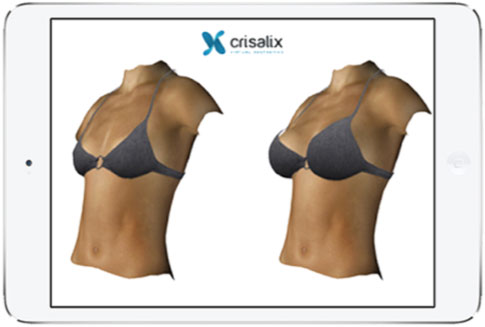 Learn More
Learn More